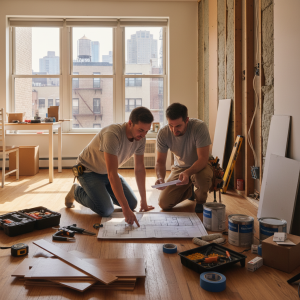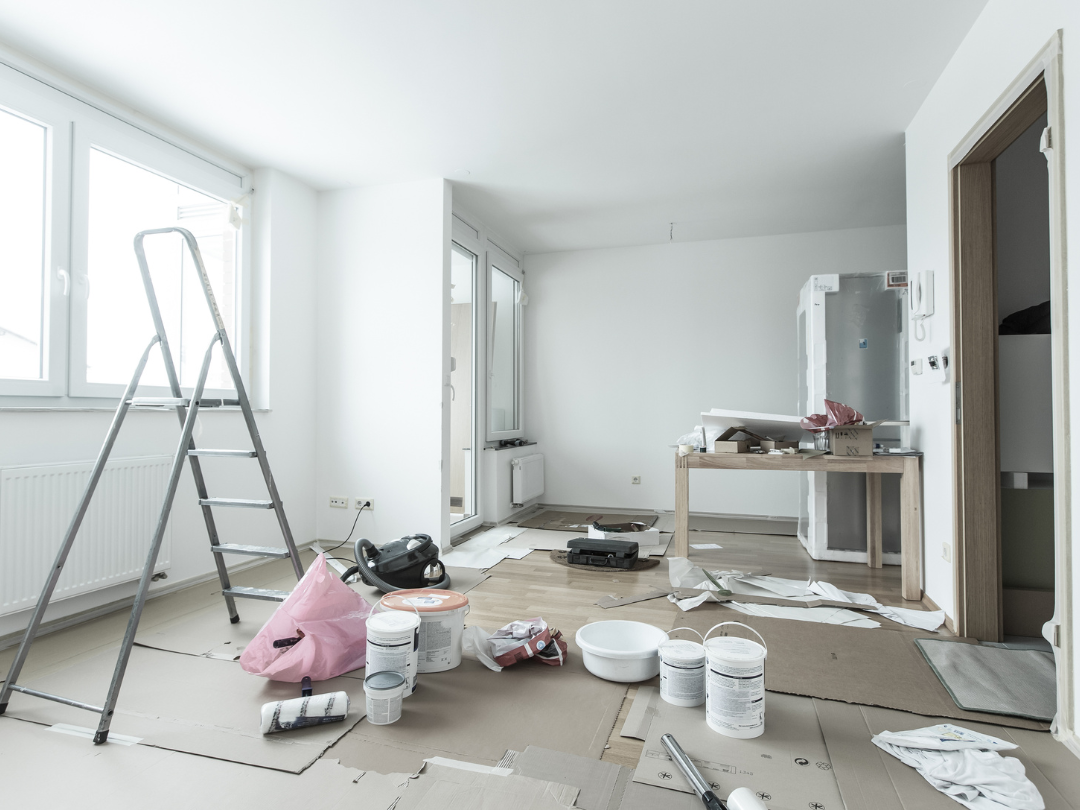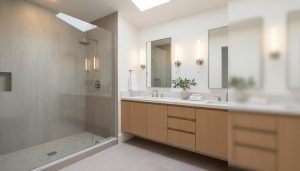Get the week's most popular posts delivered to your inbox.
Our weekly update is free yet priceless and you're less than a minute away from getting the current edition.
In the unlikely event we disappoint, you can unsubscribe with a single click!
Last Updated on November 15, 2024 by teamobn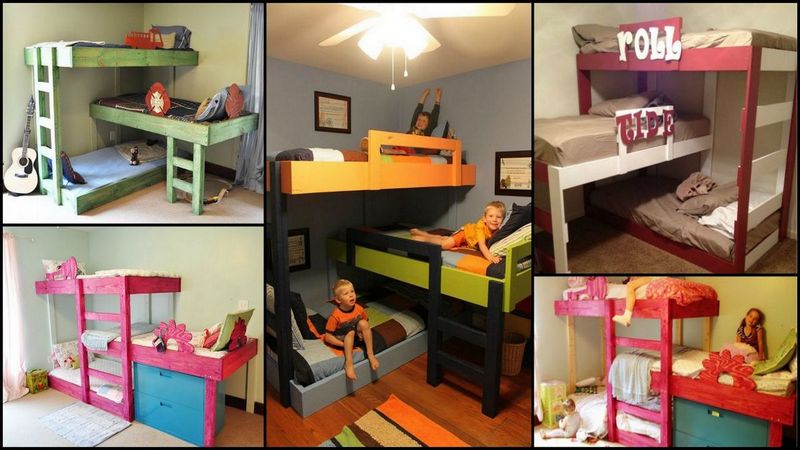
Looking for a bed that makes good use of space in a shared bedroom? Then this DIY triple bunk bed project is for you!
For those of you who grew up sharing a room with your siblings, you know that space is at a premium. You might even have experienced battles over “space.” Figuring out the right setup in a shared bedroom is very important. In most cases, buying pre-fabricated beds is not the best solution.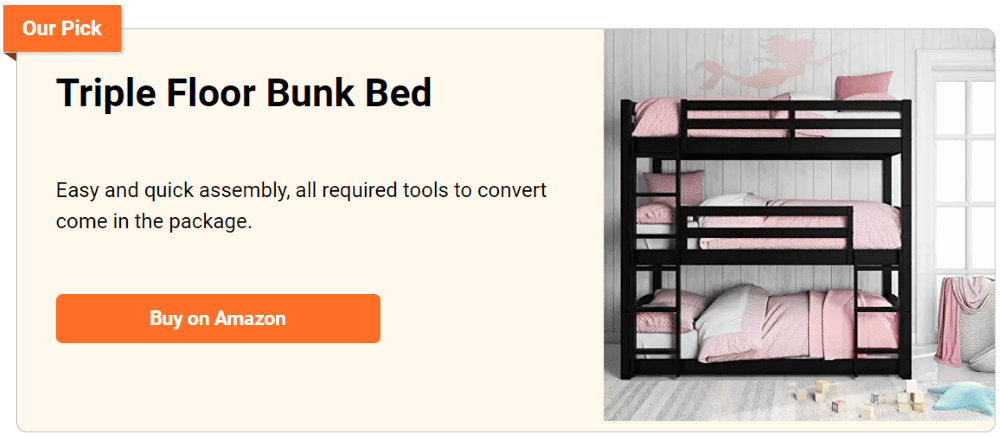
Things need to be customized to use a small space efficiently. This concept of building triple bunk bedplans are the perfect solution. The most obvious reason is that you can fit three kids in one room.
Sturdy, stylish, and budget-friendly, a well-made triple-stacked bunk-bed is great for kids who want and need a bit more room, but still want to share a space with each other!
What makes it even better is that you can configure the triple bunk bed to efficiently fit the bedroom. You can see a couple of different configurations in the album below.
These functional and gorgeous examples offer high-quality construction and designs that are both lasting and versatile.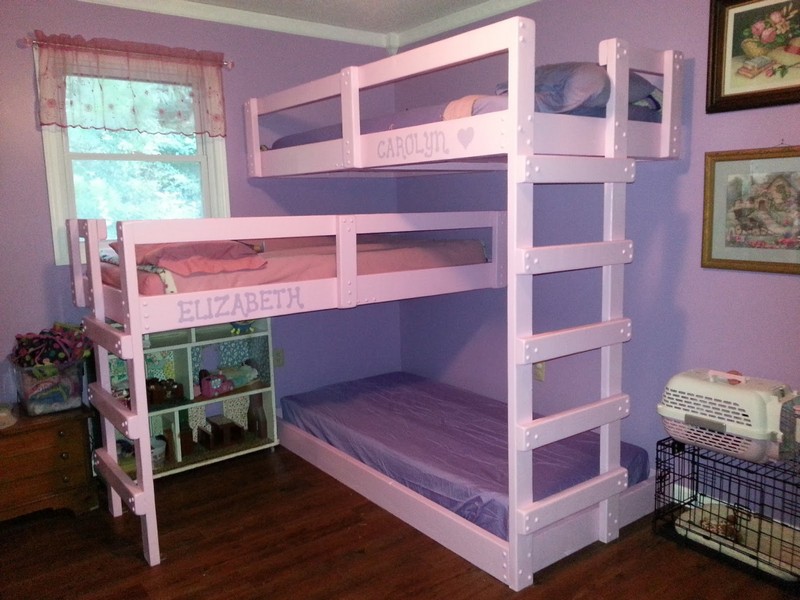
How to Build a DIY Triple Bunk Bed
Building a triple-stacked bunk bed yourself makes it easier for you to make use of the space efficiently. You can freely decide on the dimensions of the bed, allowing you to utilize the most out of the available space. Not to mention that it’s much cheaper to build it yourself, and a great way to enhance your DIY skills.
What other modifications can you add to improve this design?
Materials
- 18 carriage bolts and nuts.
- 2×6 boards
- 2×4 boards
- 2×3 boards
- 3 sheets of plywood – all cut to be 39 3/4″ x 75 inches.
- Box of wood screws 3″ long.
- Gel Stain
- Rub-on Polyurethane
Tools
- Table Saw
- Router
- Drill
- Power Hand Sander
Steps
Prepare the Materials:
- Use the table saw to cut the 2×6, 2×4, and 2×3 boards to the required bed frames and supports lengths.
- Cut the plywood sheets to match the size of the bed frames (39 3/4″ x 75 inches each).
Smooth and Shape the Wood:
- Use the router to round off the edges of the cut boards for safety.
- Sand all the cut pieces using the power hand sander for a smooth finish.
Assemble the Bed Frames:
- Construct three bed frames using the 2×6 boards and plywood sheets.
- Secure the frames by drilling holes and using the wood screws.
Build the Bed Posts:
- Cut four 2×4 boards to your desired bunk bed height. These will be the vertical supports (posts).
- Drill holes in the posts for the carriage bolts at the points where each bed frame will be attached.
Attach the Frames to the Posts:
- Align the lowest bed frame with the drilled holes on the posts. Secure it with the carriage bolts and nuts.
- Repeat the process for the middle and top bed frames, ensuring they are evenly spaced.
Reinforce the Structure:
- Add extra support under each bed frame by attaching 2×3 boards as crossbeams.
- Install side rails on the upper bunks for safety, using additional 2×4 or 2×3 boards.
Apply Finishes:
- Apply gel stain to all wooden surfaces for a consistent color and aesthetic appeal.
- Once the stain dries, apply rub-on polyurethane to protect the wood and extend the bed’s lifespan.
Final Checks:
- Inspect the entire bunk bed structure for stability.
- Ensure all bolts, nuts, and screws are tightened and secure.
Install Mattresses and Bedding:
- Place mattresses on each bunk.
- Dress the beds with appropriate bedding.
Click on any image to start the lightbox display. Use your Esc key to close the lightbox. You can also view the images as a slideshow if you prefer 😎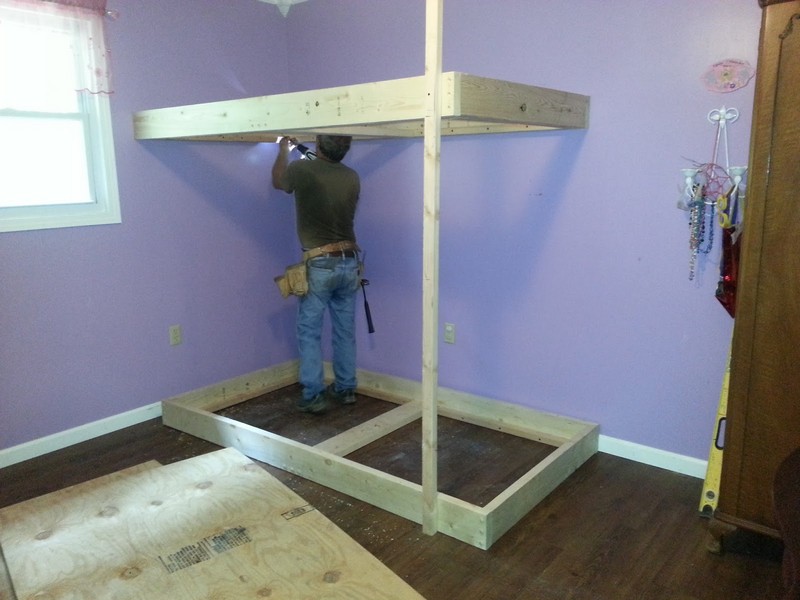
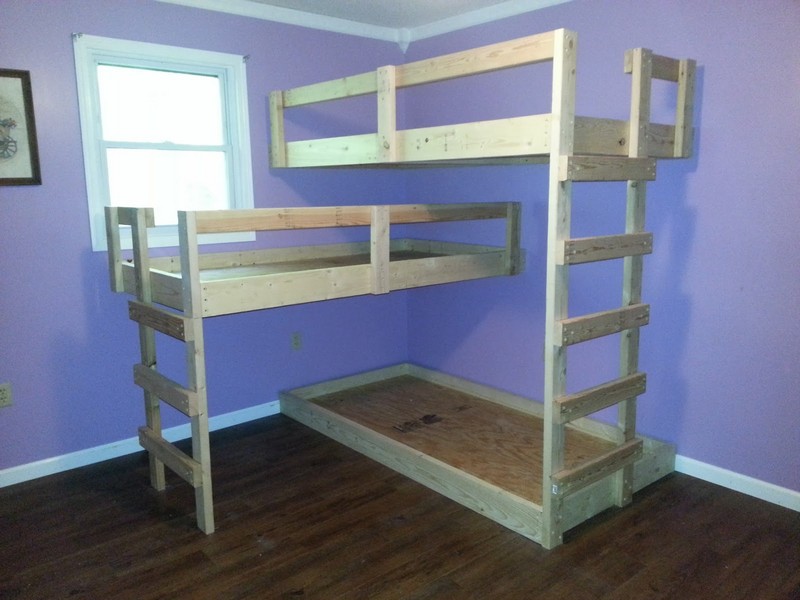
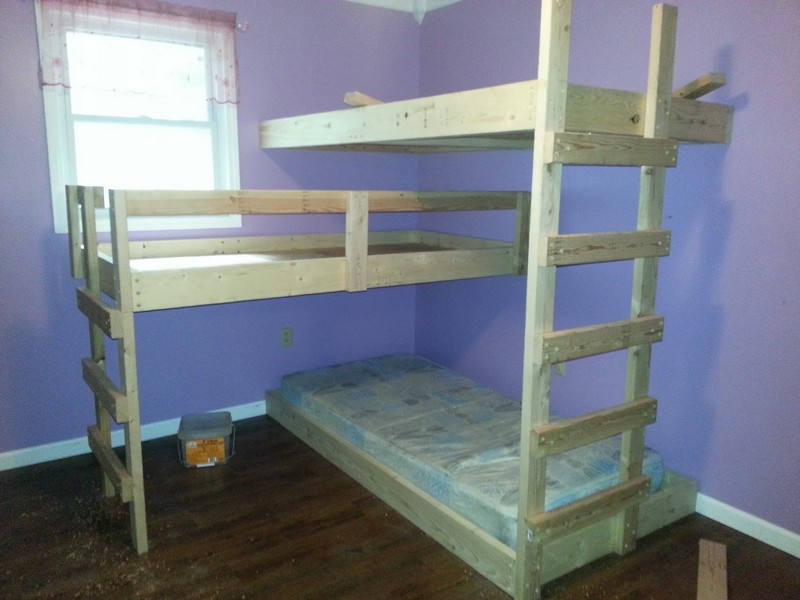
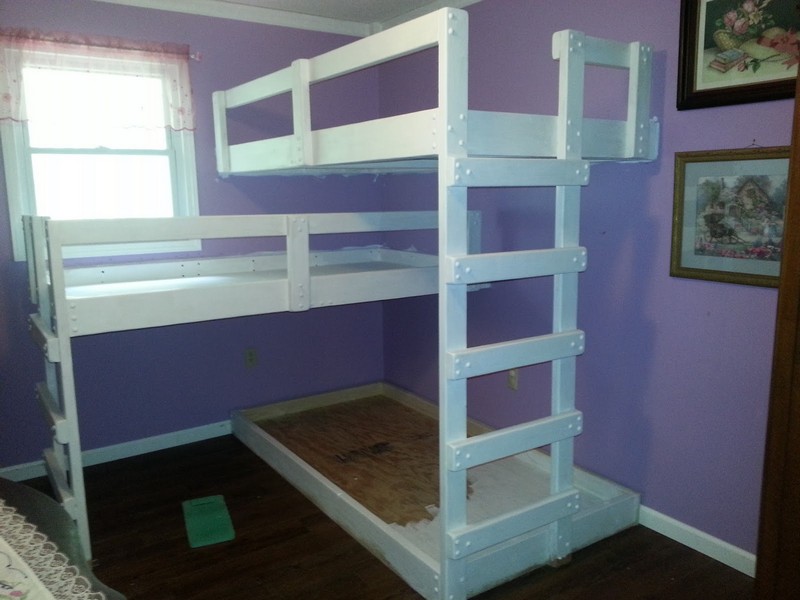

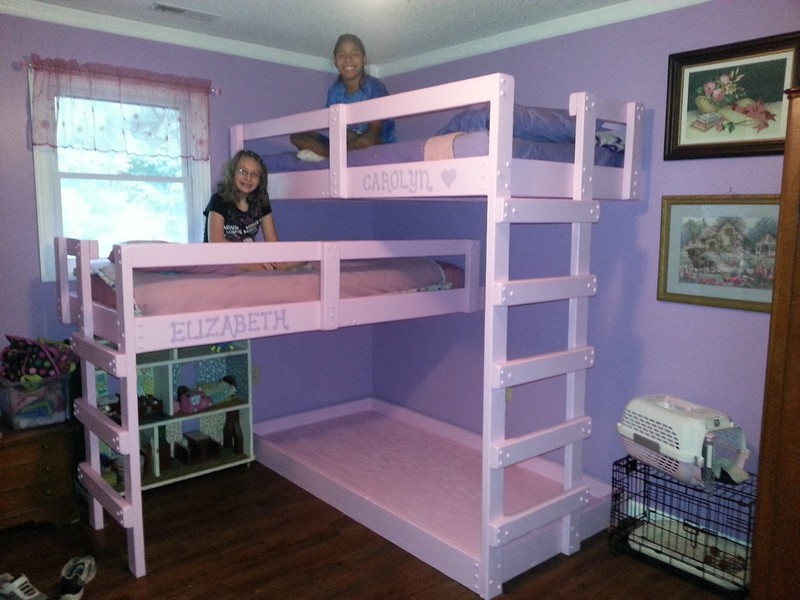
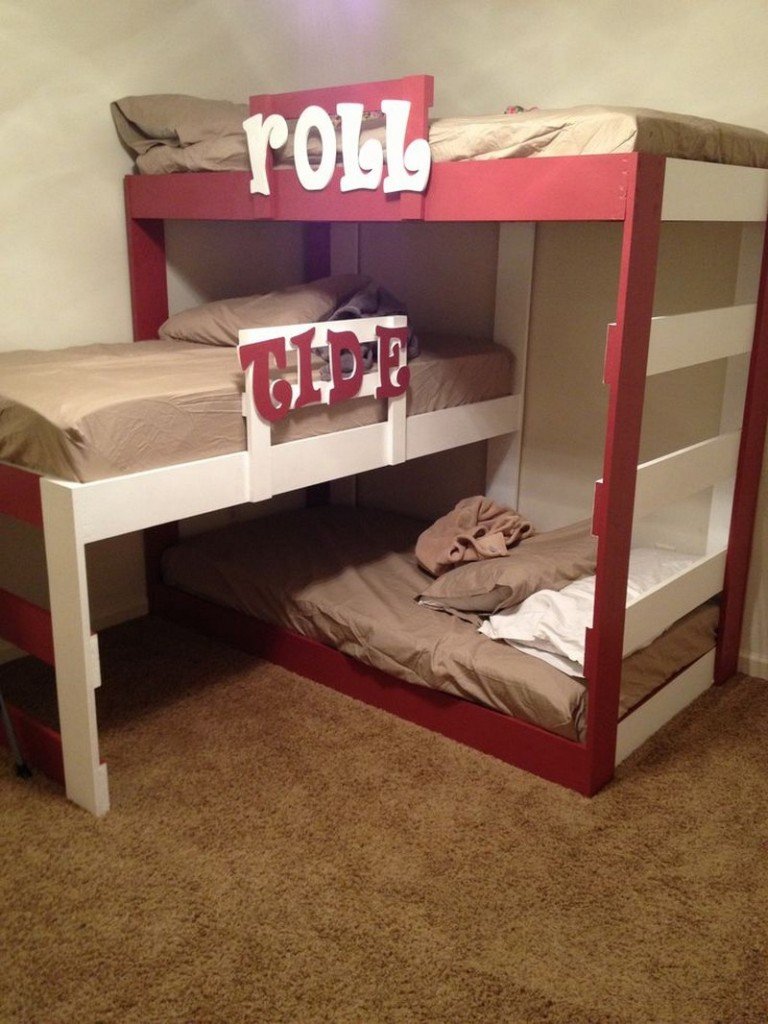
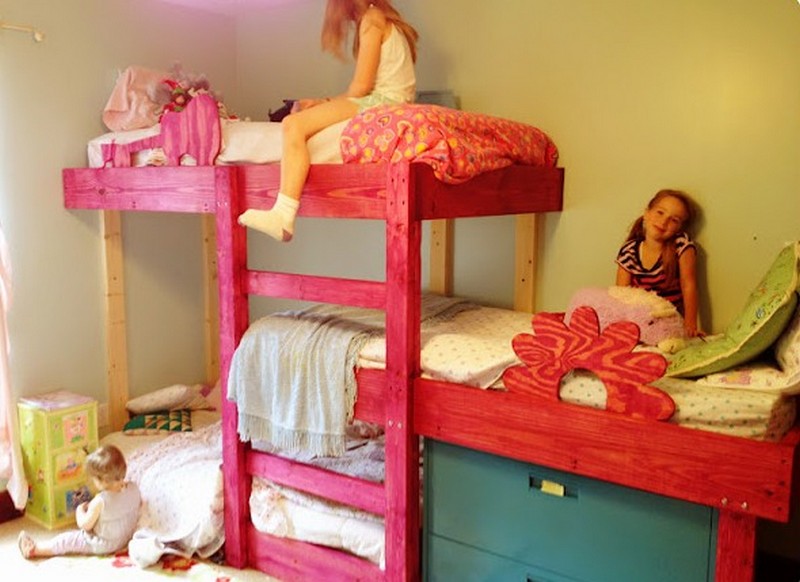
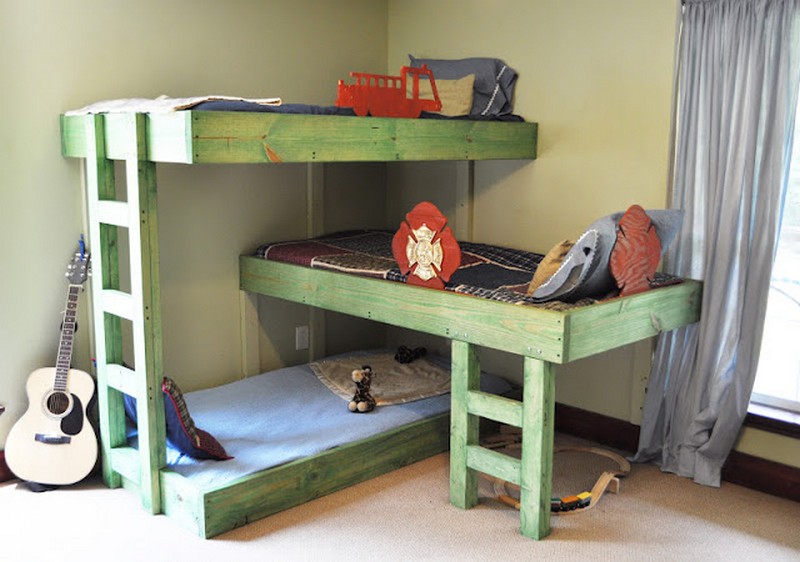
Customization Ideas for DIY Triple Bunk Beds
Building a DIY triple bunk bed is not just about creating extra sleeping space. It’s also an opportunity to add a personal touch to your home. Here, we explore various customization ideas to make your DIY triple bunk bed unique and functional.
Theme and Color Schemes
One of the easiest ways to customize your DIY triple bunk bed is by choosing a theme or color scheme. Vibrant colors for a playful kid’s room or a sleek, neutral palette for a more mature look can dramatically change the bed’s appearance. Consider themes like nautical, jungle, or space to spark children’s imagination.
Built-In Storage
Maximize space in a room with a DIY triple bunk bed by adding built-in storage. Consider incorporating drawers under the bottom bunk or shelves within the bed frame. This approach is practical for keeping bedrooms tidy and organized.
Personalized Headboards
Customize each bunk in your DIY triple bunk bed with unique headboards. You could paint them in different colors, add each child’s name, or decorate them according to their interests. This personal touch makes each bunk special for its occupant.
Creative Ladder and Stair Designs
The ladder or stairs to the upper bunks of your DIY triple bunk bed offer another opportunity for customization. You can build them in interesting shapes, integrate storage, or even create a slide for an added fun element.
Safety Features
While customizing your DIY triple bunk bed, don’t forget about safety. Adding railings, especially on the top bunk, is essential. You can design these safety features to blend with the overall theme, ensuring they are both functional and stylish.
Lighting Solutions
Proper lighting is crucial, especially for the bunks furthest from natural light sources. Consider adding individual reading lights to each bunk. You can choose from various lighting options, like LED strips or small clip-on lights, to suit the bed’s design.
Multi-Functional Design
Your DIY triple bunk bed can be more than just a sleeping area. Consider integrating a study or play area into the design. You can add a small desk under the lowest bunk or create a cozy nook for reading and relaxing.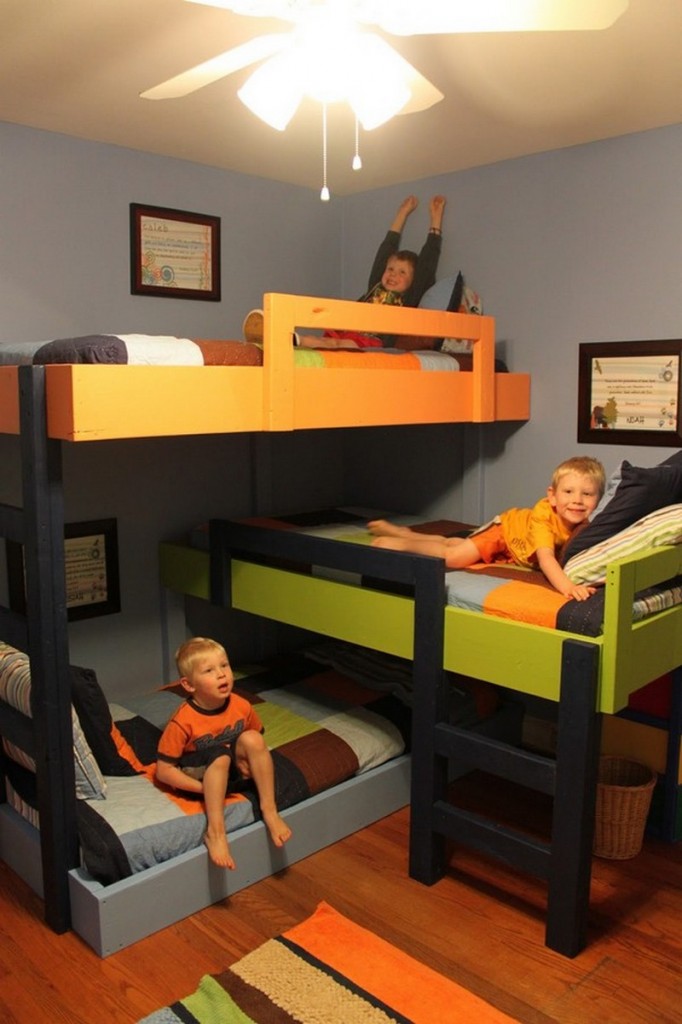
Fabric and Textile Additions
Customize each bunk with its own set of curtains for privacy. Choose fabrics that match the overall theme of the room. Add matching bedspreads, pillows, and rugs to complete the look of your DIY triple bunk bed.
Innovative Lighting Options
Enhancing your DIY triple bunk bed with creative lighting can transform both its functionality and ambiance. Consider installing individual reading lights for each bunk. LED strip lights can be added under each bunk for a modern, sleek look. You can also use fairy lights for a whimsical touch. Ensure all lighting is safely installed and out of reach of young children.
Interactive Elements
Add interactive elements to your DIY triple bunk bed to make it more than a sleeping area. Consider a chalkboard paint finish on one side for kids to draw and write. Or, install a small slide for the lower bunk, turning the bed into a play area.
Space-Themed Customizations
For a unique touch, consider a space-themed DIY triple bunk bed. Use dark colors combined with glow-in-the-dark stars and planets. You could add rocket ships or astronaut decals to the bed frames. This theme can be both educational and fun for children.
Incorporate Technology
Integrate technology into your DIY triple bunk bed design. This could include built-in speakers, USB charging ports, or small movie-screen screens. Ensure all electrical installations are done safely and comply with local regulations.
Fabric Draping and Canopies
Create a cozy atmosphere by adding fabric draping or canopies to your DIY triple bunk bed. Light, airy fabrics can create a sense of privacy and comfort. They can also be themed to match the overall decor of the room.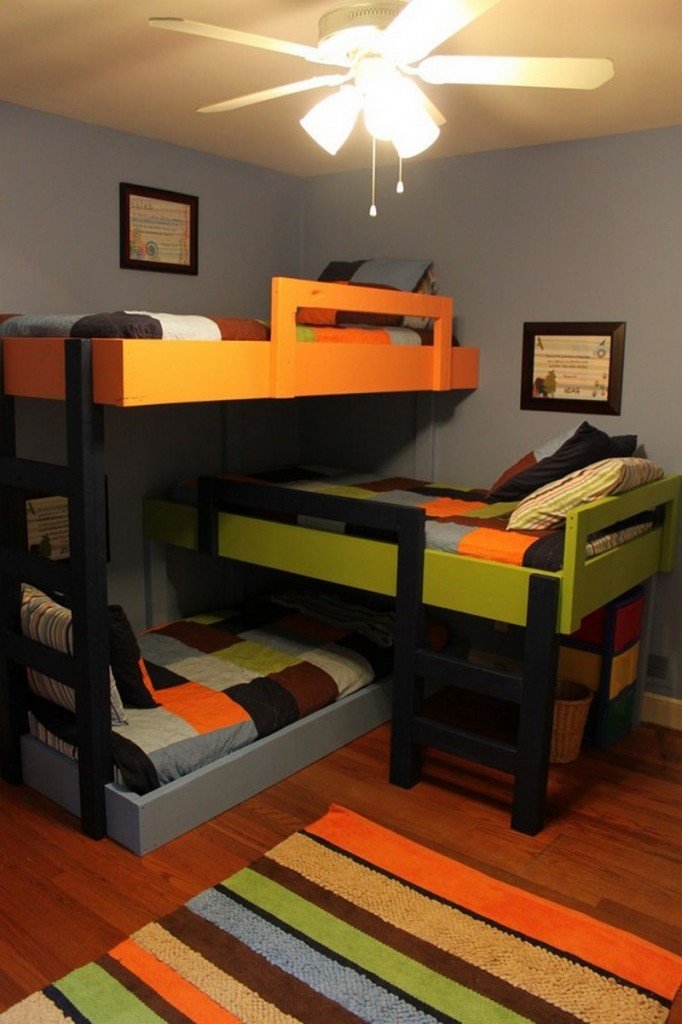
Wall Art and Decals
Customize the walls around your DIY triple bunk bed with art or decals. Choose themes or designs that reflect the interests of the bed’s occupants. This not only personalizes the space but also enhances the overall room decor.
Convertible Design Features
Consider adding features that allow your DIY triple bunk bed to grow with your family. Include elements easily modified or removed, such as a detachable lower bunk that can become a separate single bed.
These customization ideas for a DIY triple bunk bed enhance its functionality and make it a standout piece in any room. With creativity and thoughtful design, your DIY triple bunk bed can be a practical and stylish addition to your home.
Maintenance and Care Tips for Your DIY Triple Bunk Beds
Keeping your DIY triple bunk bed in top condition is crucial for safety and longevity. Here are some essential maintenance and care tips to ensure your DIY triple bunk bed remains a safe, sturdy, and beautiful in your home.
Regular Inspection
Regularly inspecting your DIY triple bunk bed ensures its safety and longevity. Make it a routine to check the stability of the bed, especially the bolts, nuts, and screws. The bed’s primary fastening elements can loosen over time due to regular movement and use.
Tighten any loose parts immediately upon discovery. Inspect for any signs of wear, cracks, or splintering, particularly in the areas with the most weight. Regular inspections help in the early detection of potential issues, ensuring the bed remains safe and durable for prolonged use.
Wood Care
Wood is a popular choice for DIY triple bunk beds, but it requires proper maintenance. Regularly clean the wood surfaces to keep them looking fresh and to extend their lifespan. Use a dry or slightly damp cloth to wipe down the surfaces, effectively removing dust and dirt. It’s important to avoid harsh chemicals and abrasive cleaners, as they can strip the wood of its natural oils and damage the finish.
Use a mild wood cleaner for tougher stains, but always test it on a small, inconspicuous area first. Keeping the wood clean preserves its appearance and allows you to spot any potential issues like cracks or splinters early on.
Protective Coatings
Protective coatings are essential in maintaining your DIY triple bunk bed. These coatings, such as polyurethane or a suitable paint, serve multiple purposes. Firstly, they enhance the bed’s appearance, giving it a fresh, new look and allowing customization to match your room’s décor. More importantly, these coatings provide a barrier against moisture and wear. Moisture can particularly damage wood, leading to warping or mold growth.
A protective coating helps to seal the wood, keeping it dry and preventing damage from spills or humidity. Reapply the coating as needed, depending on wear and tear and the manufacturer’s recommendations. This keeps your bed looking great and extends its life, ensuring it remains a sturdy and attractive piece of furniture in your home.
Avoid Excess Weight
When using your DIY triple bunk bed, it’s essential to be mindful of weight limits. Each bunk should have a clearly defined maximum weight capacity, typically determined by the strength of the materials used in construction. Exceeding these limits can put undue strain on the bed’s structure.
This not only risks the immediate safety of the users but can also lead to long-term damage to the bed, such as bent frames or weakened joints. Regularly remind those using the bunk beds, especially children, of these limits to ensure their safety and the bed’s integrity.
Avoid Moisture
Moisture is a significant enemy of wooden furniture, and your DIY triple bunk bed is no exception. Excessive moisture can cause the wood to warp, swell, or even rot, compromising the bed’s structural integrity. To protect your bed, place it away from direct exposure to water or moisture sources like humidifiers, windows, or bathrooms.
If your bunk bed does come into contact with water, dry it off as quickly as possible with a soft, dry cloth. Regularly check for signs of moisture damage, especially in hidden areas, to address any issues before they become severe.
Address Damage Promptly
The durability of your DIY triple bunk bed largely depends on how quickly you address any damage. Regular inspections can help you spot problems like a cracked board, a loose joint, or a broken rail early on. If you do find damage, repair it immediately.
Delaying repairs can lead to more significant problems, risking the users’ safety and potentially leading to more costly fixes. You might be able to do simple repairs yourself with basic tools. Consider seeking professional help to ensure the repairs are done correctly and safely for more complex issues. Keeping your DIY triple bunk bed well-maintained extends its lifespan and ensures it remains a safe and sturdy piece of furniture in your home.
Proper Mattress Care
Choosing the right size mattresses for your DIY triple bunk bed is crucial. Too small mattresses can leave dangerous gaps, while oversized mattresses can be compressed and lose their supportive qualities. Once the right mattresses are in place, regular maintenance is key to their longevity and comfort. This includes flipping or rotating them every few months to ensure even wear.
Over time, mattresses can develop dips or become less supportive in certain areas, particularly where they are most frequently used. By rotating or flipping them, you can help distribute the wear more evenly, prolonging their life and maintaining the comfort and support they provide. Remember, a well-maintained mattress is not just about comfort; it’s also about safety. A good-condition mattress contributes to the bunk bed’s overall stability and safety.
Safety Rail Checks
The safety rails on your DIY triple bunk bed, especially for the upper bunks, are vital for preventing falls. Regular checks of these rails are a key safety measure. Ensure all rails are firmly attached and stable with no wobble or give. Over time, the connections can loosen, particularly with the normal movement and activity that bunk beds see.
If any part of the safety rail feels loose or unstable, tighten it immediately. Also, inspect the rails for any signs of damage or wear, such as cracks or splintering, which could weaken their effectiveness. Remember, the safety rails are an essential component of your DIY triple bunk bed, and their integrity is critical to ensuring the safety of whoever sleeps in it.
Avoid Modifications
Modifying your DIY triple bunk bed to suit changing needs or preferences can be tempting, so it’s important to approach this cautiously. Any modifications should be carefully considered and planned. Avoid making changes that could compromise the structural integrity or safety of the bed. This includes altering the frame, removing or altering safety rails, or adding weight beyond what the bed was designed to support.
If you are considering modifications, consulting with someone knowledgeable in carpentry or structural design is advisable. They can help ensure any changes won’t negatively impact the bed’s safety or function. Remember, the primary purpose of your DIY triple bunk bed is to provide a safe and comfortable sleeping environment. Any modifications should align with this purpose.
Following these maintenance and care tips, your DIY triple bunk bed will remain a safe, comfortable, and beautiful addition to your home for years to come.
FAQ for DIY Triple Bunk Bed Plans
- How much space is needed for a DIY triple bunk bed?
- The space required depends on the bed dimensions you plan to build. Typically, you need a room with a high ceiling (at least 9 feet) to comfortably accommodate a triple bunk bed and ensure enough headroom for each bunk.
- Is building a DIY triple bunk bed cost-effective compared to buying a pre-made one?
- Yes, building a DIY triple bunk bed can often be more cost-effective. It allows you to choose materials within your budget and avoid the costs associated with pre-made furniture, like branding and retail markup.
- What safety concerns should I know about a DIY triple bunk bed?
- The key safety concerns are ensuring the bed is structurally sound, the guardrails on the upper bunks are secure, and the ladder is stable. Regularly inspect the bed for any loose screws or weakened parts.
- Can I customize the bed to fit a small room?
- Absolutely. One of the benefits of a DIY triple bunk bed is that you can design it to fit specific room dimensions. You can adjust the length, width, and height to suit a smaller space.
- What is the recommended age for children to use the top bunk?
- Generally, it’s recommended that children under the age of 6 do not use the top bunk due to safety concerns.
- How do I choose the right mattresses for my DIY triple bunk bed?
- Select mattresses that fit the dimensions of each bunk without exceeding the bed frame. Ensure enough room between the mattress top and the guardrails for safety.
- Can I add extra storage to my DIY triple bunk bed?
- You can customize your bunk bed to include storage options like drawers or shelves. This can be especially useful in maximizing space in small rooms.
- How often should I inspect and maintain the bunk bed?
- Perform a thorough inspection every 6 months, checking for loose components, signs of wear, or structural issues. Regular maintenance, like tightening screws and applying protective finishes, is also crucial.
- Is it possible to separate the bunks into individual beds later on?
- This depends on your initial design. If you plan for this adaptability from the start, you can construct the bed to be separated into individual units.
- What creative themes can I use for my DIY triple bunk bed?
- Popular themes include space exploration, nautical adventures, jungle safari, or a princess castle. Choose a theme that aligns with your children’s interests and the room’s decor.
- What are the steps involved in building the ladder for a DIY triple bunk bed?
- With the right materials, equipment, and steps, you can build a triple bunk bed ladder. Start by cutting solid side rails to the right height and properly spaced rungs for easy footing. Sand all components for smooth edges, then build the ladder by joining rungs with wood glue and screws and bolting essential connections. Sand rough surfaces, apply a non-toxic finish, then firmly attach the ladder to the bunk bed frame for stability and safety.
- How are the mattress boxes for a DIY triple bunk bed constructed?
- Constructing mattress boxes for a triple bunk bed requires precise measurement and assembly for durability. Start by cutting lumber to size, assembling the rectangular frames, and evenly attaching slats for support. Pre-drill holes to prevent splitting, securely fasten all components, and test stability before stacking the boxes for a safe and functional bed.
- What is the process for building the side panels of a DIY triple bunk bed?
- To build the side panels for a triple bunk bed, start by drilling pocket holes into the ends of the rails for precise connections. Attach the rails to the legs using pocket screws and wood glue, ensuring a secure and reinforced fit. Adjust for ceiling variations if needed, then verify stability and alignment for a sturdy and reliable structure.
- How do you build the back panel of a DIY triple bunk bed?
- To construct the back panel for a triple bunk bed, measure and cut wood rails to size and ensure the legs are uniform. Drill pocket holes into the rails, then attach them to the legs with wood glue and pocket screws for a clean, secure fit. Check the assembled panel for stability and alignment, making adjustments as needed for a safe and sturdy finish.
- How do you build the front panel of a DIY triple bunk bed?
- To build the front panel for a triple bunk bed, start by preparing your materials and drilling pocket holes into the ends of each rail for secure connections. Attach the rails to the legs using wood glue and pocket screws, ensuring a strong and stable assembly. Check the alignment with a carpenter’s square, making adjustments as needed to create a straight and sturdy frame.
- What is the benefit of using specific bedding for the DIY triple bunk bed project?
- Choosing the right bedding for a DIY triple bunk bed simplifies maintenance and enhances functionality. All-in-one bedding solutions fit snugly, making bed-making quicker and easier, especially in tight spaces. These sets provide a neat, clutter-free appearance while maximizing both practicality and aesthetics in a shared room.
Conclusion
Building a DIY triple bunk bed offers a unique combination of practicality, creativity, and cost-effectiveness. This project not only maximizes space in shared bedrooms but also brings a personal touch to your home décor. You can create a functional and stylish sleeping solution that meets your family’s needs by following the guidelines, safety tips, and customization ideas.
If you liked this project, you will also like viewing these bunk bed ideas…
Get the week's most popular posts delivered to your inbox.
Our weekly update is free yet priceless and you're less than a minute away from getting the current edition.
In the unlikely event we disappoint, you can unsubscribe with a single click!


